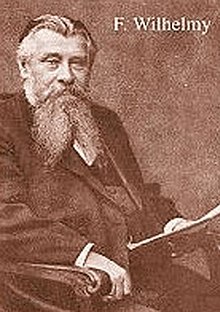Ludwig Ferdinand Wilhelmy
Ludwig Ferdinand Wilhelmy (born December 25, 1812 in Stargard , † February 18, 1864 in Berlin ) was a German physicist and physical chemist. In 1850 he published the first quantitative study of chemical kinetics.
Wilhelmy studied pharmacy at the University of Berlin and then took over his father's pharmacy in Stargard. Since he wanted to work scientifically, he sold his pharmacy in 1843 and studied chemistry and physics in Berlin, Giessen and Heidelberg. In 1846 he received his doctorate in Heidelberg (Heat, as a measure of cohesion) . He then went to Italy and Paris, where he heard Henri Victor Regnault's lectures. From 1849 to 1854 he was a private lecturer in Heidelberg (where he researched the rotation of the plane of polarization in various substances and thermal radiation), lived in Munich for six months and then was a private scholar in Berlin, where he dealt with philosophy, physics and mathematics.
Wilhelmy studied the breakdown of cane sugar by acids into a mixture of fructose and galactose, which he observed with a polarimeter . He described the reaction with a differential equation and he found that the reaction rate was proportional to the concentration of cane sugar and acid. He also examined the influence of temperature. In his time, the investigations received relatively little attention, but only with the work of Jacobus Henricus van 't Hoff and Svante Arrhenius at the end of the 19th century.
Marcelin Berthelot undertook similar attempts with Péan de Saint-Gilles in ester hydrolysis in the early 1860s, which had an influence on the development of the law of mass action by Cato Maximilian Guldberg and Peter Waage (1864) (whose work, however, received little attention for a long time).
A method for measuring surface tension is named after him (Wilhelmy plate, Wilhelmy equation), whereby a thin plate (which is completely wetted by the liquid) is pulled out of the liquid and the force is measured.
As a student he took part in the Physics Colloquium of Wilhelm Magnus in Berlin and founded the forerunner of the German Physical Society in 1845 with other participants . When he returned to Berlin, he was again active in society and in 1855 donated a prize for answering the question about the mechanical heat equivalent. The prize went to Gustav-Adolf Hirn in Logelbach near Colmar in 1857 (judges included Rudolf Clausius ). He made friends with Georg Quincke (later professor in Heidelberg) and ran a private physics laboratory with him from 1860 to 1864 in his house at the Anhaltisches Tor in Berlin. Wilhelmy also had a villa in Heidelberg as a summer residence. There and in his Berlin house he undertook his attempts at capillarity, which he could not complete because he died surprisingly in 1864 of pneumonia.
literature
- Viktor A. Kritsman: Ludwig Wilhelmy, Jacobus H. van't Hoff, Svante Arrhenius and the history of chemical kinetics , Chemistry in our time, Volume 31, No. 6, 1997, pp. 269-300.
Fonts
- Ludwig Wilhelmy: About the law according to which the action of acids on cane sugar takes place (1850), Ostwalds Klassiker 29, Leipzig 1891, with the curriculum vitae of Georg Quincke, Archive , (first Annalen der Physik und Chemie 81 , pp. 413-433 and pp. 499-532 (1850))
Web links
| personal data | |
|---|---|
| SURNAME | Wilhelmy, Ludwig Ferdinand |
| BRIEF DESCRIPTION | German chemist and physicist |
| DATE OF BIRTH | December 25, 1812 |
| PLACE OF BIRTH | Stargard |
| DATE OF DEATH | February 18, 1864 |
| Place of death | Berlin |
